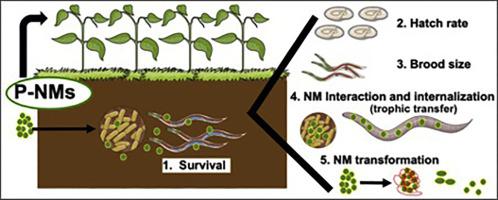NanoImpact ( IF 4.9 ) Pub Date : 2021-06-02 , DOI: 10.1016/j.impact.2021.100327 Ayushi Priyam 1 , Luis O B Afonso 2 , Aaron G Schultz 2 , Pushplata Prasad Singh 1

|
Biogenic phosphorus (P) based – nanomaterials (NMs) are currently being explored as nanofertilizers. In this study, the acute toxic effects and trophic transfer of multiple types of P-based NMs were examined on soil-dwelling nematode, Caenorhabditis elegans. The study involved four variants of nanohydroxyapatites (nHAPs) synthesized either via a biogenic or a chemical route and another NM, nanophosphorus (nP), biosynthesized from bulk rock phosphate (RP). The pristine NMs differed in their physicochemical properties with each possessing different shapes (biogenic nHAP: platelet-shaped, ˜35 nm; biogenic nP, ˜5–10 nm: dots; chemically synthesized nHAPs: spherical, ˜33 nm, rod, ˜80 nm and needle-shaped, ˜64 nm). The toxic effects of NMs' in C. elegans were assessed using survival, hatching and reproductive cycle as the key endpoints in comparison to bulk controls, calcium phosphate and RP. The interactions and potential uptake of fluorescent-tagged nHAP to E. coli OP50 and C. elegans were investigated using confocal microscopy. The transformation of NMs within the nematode gut was also explored using dynamic light scattering and electron microscopy. C. elegans exposed to all of the variants of nHAP and the nP had 88–100% survival and 82–100% hatch rates and insignificant effects on brood size as observed at the tested environmentally relevant concentrations ranging from 5 to 100 μg.mL−1. Confocal microscopy confirmed the interaction and binding of fluorescent-tagged nHAP with the surface of E. coli OP50 and their trophic transfer and internalization into C. elegans. Interestingly, there was only a small reduction in the hydrodynamic diameter of the nHAP after their uptake into C. elegans and the transformed NMs did not induce any additional toxicity as evident by healthy brood sizes after 72 h. This study provides key information about the environmental safety of agriculturally relevant P-based NMs on non-target species.
中文翻译:

磷基纳米农用材料在秀丽隐杆线虫体内的营养转移和急性毒性研究
基于生物磷 (P) 的纳米材料 (NM) 目前正在作为纳米肥料进行探索。在这项研究中,研究了多种基于 P 的 NMs 对土壤线虫秀丽隐杆线虫的急性毒性作用和营养转移。该研究涉及通过生物或化学途径合成的四种纳米羟基磷灰石 (nHAP) 变体和另一种 NM,即纳米磷 (nP),由散装磷酸盐 (RP) 生物合成。原始 NM 的物理化学性质不同,每个都具有不同的形状(生物 nHAP:片状,~35 nm;生物 nP,~5-10 nm:点;化学合成的 nHAP:球形,~33 nm,棒状,~80 nm 和针状,约 64 nm)。NMs 对秀丽隐杆线虫的毒性作用与散装对照、磷酸钙和 RP 相比,使用存活、孵化和生殖周期作为关键终点进行了评估。使用共聚焦显微镜研究了荧光标记的 nHAP 对大肠杆菌OP50 和秀丽隐杆线虫的相互作用和潜在吸收。还使用动态光散射和电子显微镜研究了线虫肠道内 NM 的转化。暴露于所有 nHAP 和 nP 变体的秀丽隐杆线虫具有 88-100% 的存活率和 82-100% 的孵化率,并且在 5 到 100 μg.mL 的测试环境相关浓度下观察到对育雏大小的影响微不足道- 1. 共聚焦显微镜证实了荧光标记的 nHAP 与大肠杆菌OP50 表面的相互作用和结合,以及它们的营养转移和内化到秀丽隐杆线虫中。有趣的是,nHAP 在摄入秀丽隐杆线虫后,其流体动力学直径仅小幅减小,并且转化的 NM 不会引起任何额外的毒性,这在 72 小时后健康的育雏大小可以证明这一点。本研究提供了有关非目标物种的农业相关 P 基 NM 的环境安全性的关键信息。


























 京公网安备 11010802027423号
京公网安备 11010802027423号